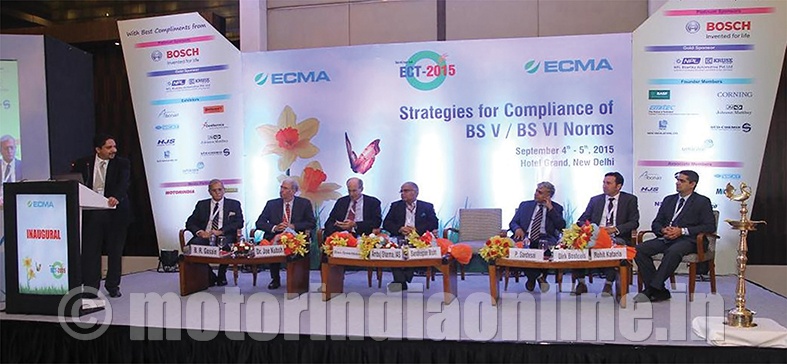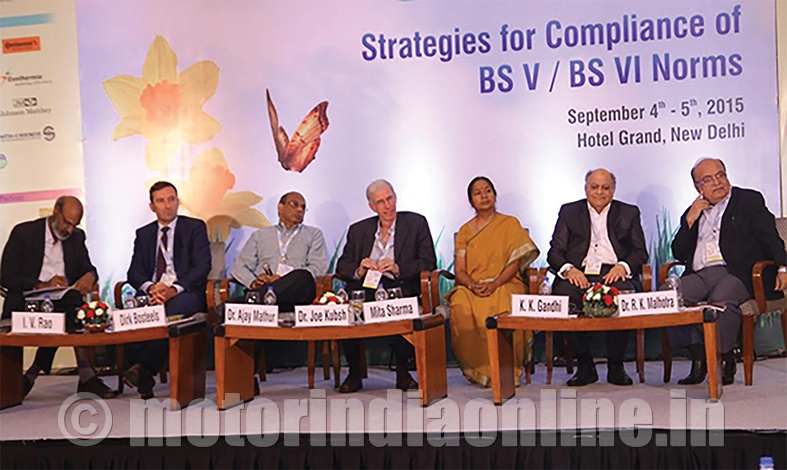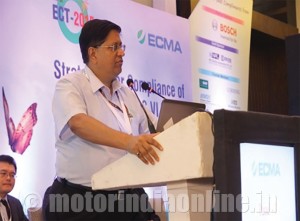The eighth international conference ECT 2015 held in New Delhi on September 4 and 5 by the Emission Controls Manufacturers Association (ECMA) had a wide-ranging discussion on the strategies for compliance to BS V / BS VI norms.

In his inaugural address, Mr. Sandeepan Bisht, Vice President, ECMA, outlined the significance of the conference and the major issues to be discussed.
In his address, Mr. Prakash Sardesai, Member, ECMA, said that the new areas to be covered during the discussion were emission from locomotive & power generation, urea availability for automotive applications and the fuel quality roadmap. He also highlighted the ECT’s successful journey from 2006 to 2015.
Mr. Ambuj Sharma, Additional Secretary, Department of Heavy Industries (MoHI&PE), who was the chief guest on the occasion, highlighted the effects and sources of vehicular pollution. While the Government has finally notified BS IV and laid out a plan for BS V and BS VI, there are over 200 million vehicles, with a few of them more than 15 years old, adding to the pollution level. Hence the urgent need for a policy on condemning old vehicles.

He pointed out that distance, height and approach between roads and the residents living closeby are factors determining the impact of pollution on the population. Delhi is a typical example of growing pollution caused by old vehicles.
The first session held on the occasion was on Light Duty Vehicles / Passenger Vehicles: Understanding the details and implications of BS V and BS VI Emissions Standards. It was chaired by Mr. Sanjay Bandopadhyaya, Joint Secretary, Ministry of Road Transport & Highways (MoRT&H), who spoke on the evolution of the next stages of norms after BS IV and the possibility of perhaps moving to BS VI directly.
The second session on heavy-duty commercial vehicles, presided over by Mr. S.R. Marathe, former Director of ARAI, discussed advancement of the emission control technology to enhance fuel efficiency, the relevance of vehicle speeds, traffic control measures, etc.
Discussions centered around methods to control pollution by aftertreatment, options for reducing pollution through engine or aftermarket measures, challenge for redesigning vehicles and engines, etc. All this would make it essential for OEMs to have a thorough check on COP.
Another issue that came up for discussion was the climate in India, especially for evaporative emissions, which is somewhat similar to the US rather than Europe.
Dr. Anirudh Gautam (RITES) chaired the third session on emission control from locomotive engines and power generation. Mr. N.R. Raje, former Director – IOC R&D, and Member EPCA & Environment Impact Assessment Committee of MoEF, chaired the fourth session on the roadmap for fuel quality upgradation and flexi fuel. Various options of alternative fuels to improve and meet future emission norms were discussed in detail.

The session on health concerns due to pollution was chaired by Dr. B. Sengupta, former Member-Secretary, CPCB. It emerged during the discussion that the main focus should be on ambient air-quality standards, both outdoor and indoor. It was suggested that Global Burden of Disease (GBD) mapping earlier planned for large areas in India should be taken up to present reliable and genuine data on the air quality, taking into consideration a comprehensive source apportioning.
The sixth session, on Suitable Retrofitment as a tool to combat Emissions, was chaired by Mr. B. Bhanot (TEDC BIS). During the discussion, an interesting comment made by NEERI was that every vehicle taken up for retrofit behaved differently, thus constituting a major challenge. The Delhi Transport Department is looking for solutions to be implemented and enforced. Retrofitment product design should be sustained in the industry, hence the need to fit the same by authorized centers of OEMs.
The session on Policy Mechanism to ensure Urea / AUS-32 supply was presided over by Mr. K.K. Gandhi of SIAM. It was pointed out that in India urea, being a farm-based, licensed commodity, is not easily available for automotive use and has to be imported. The requirement of urea from 2017 onwards will cross 1,000 million litres. By 2020, a viable solution to ensure adequate supply of the product would definitely be found. European experiences of SCR which is the mainstream technology for heavy duty/off road and also for light duty for Euro VI were shared. The use of SCR could also save upto 6% of fuel consumption.
Need for having anti-tampering measures so that Ad Blue is not diluted. Technical issues such as deposit formation and mitigation of this on SCR catalysts were discussed. It was pointed out that economies of scale had not accrued on Ad Blue price and also Diesel was at an all-time low on price, hence the price discrepancy and suggested Government subsidy to encourage use of Urea and SCR. Concern with contamination of Ad Blue and the detrimental effect it will have on the image of SCR applications.
Dr. Ajay Mathur of BEE chaired the closing session on Review Progress of AFV&P 2025 and preparedness – Nationwide Availability of BS V / BS VI Fuel and Implementation of Roadmap.
Mr. Rohit Kataria, Secretary, ECMA, proposed a vote of thanks.